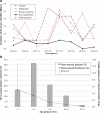Invasive group A Streptococcus disease in Australian children: 2016 to 2018 - a descriptive cohort study
- PMID: 31888568
- PMCID: PMC6937995
- DOI: 10.1186/s12889-019-8085-2
Invasive group A Streptococcus disease in Australian children: 2016 to 2018 - a descriptive cohort study
Erratum in
-
Correction to: Invasive group A Streptococcus disease in Australian children: 2016 to 2018 - a descriptive cohort study.BMC Public Health. 2021 May 3;21(1):855. doi: 10.1186/s12889-021-10798-6. BMC Public Health. 2021. PMID: 33941133 Free PMC article. No abstract available.
Abstract
Objectives: Invasive group A Streptococcus (iGAS) disease is serious and sometimes life-threatening. The Paediatric Active Enhanced Disease Surveillance (PAEDS) Network collects voluntary notifications from seven major Australian paediatric hospitals on patients with certain conditions, including iGAS disease. Our aims were to: 1) Describe the epidemiological distribution of paediatric iGAS disease in Australia and correlate this with influenza notifications, 2) Identify GAS strains commonly associated with invasive disease in children.
Methods: IGAS and influenza notification data were obtained (from the PAEDS Network and the Australian Institute of Health and Welfare, respectively, for the period 1 July 2016 to 30 June 2018). Included iGAS patients had GAS isolated from a normally sterile body site. Data were described according to selected clinical and demographic characteristics, including by age group and Australian State, with proportions and minimum incidence rates estimated.
Results: A total of 181 patients were identified, with most (115, 63.5%) <5 years old. The mean annual minimum incidence rate was 1.6 (95% confidence interval: 1.1-2.3) per 100,000 children across the study period. An epidemiological correlation with the seasonal burden of influenza was noted. Contact prophylaxis was not consistently offered. Of 96 patients with emm-typing results available, 72.9% showed emm-1, -4 or - 12.
Conclusions: Robust surveillance systems and cohesive patient management guidelines are needed. Making iGAS disease nationally notifiable would help facilitate this. Influenza vaccination may contribute to reducing seasonal increases in iGAS incidence. The burden of disease emphasises the need for ongoing progress in GAS vaccine development.
Keywords: Child health; Group A Streptococcus; Infectious diseases; Invasive; Public health.
Conflict of interest statement
None.
Figures



References
-
- Royal Children’s Hospital, Melbourne . Clinical Practice Guidelines. 2019.
-
- Javouhey E, Bolze PA, Jamen C, Lina G, Badiou C, Poyart C, Portefaix A, Tristan A, Laurent F, Bes M, et al. Similarities and differences between staphylococcal and streptococcal toxic shock syndromes in children: results from a 30-case cohort. Front Pediatr. 2018;6:1. doi: 10.3389/fped.2018.00360. - DOI - PMC - PubMed
-
- O’Loughlin RE, Roberson A, Cieslak PR, Lynfield R, Gershman K, Craig A, Albanese BA, Farley MM, Barrett NL, Spina NL, et al. The epidemiology of invasive group a streptococcal infection and potential vaccine implications: United States, 2000–2004. Clin Infect Dis. 2007;45(7):853–862. doi: 10.1086/521264. - DOI - PubMed
MeSH terms
Grants and funding
LinkOut - more resources
Full Text Sources
Medical

